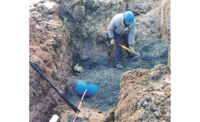In the event of a workplace emergency, the sooner first responders are called, the faster the injured person will get medical support.
In an emergency situation, time is of the essence. When an employee at a worksite is exposed to hazardous chemicals, length of response time for drenching the affected area and receiving proper post-medical care becomes a crucial factor in mitigating pain, discomfort and permanent bodily damage.
Using new signaling technology coupled with each emergency fixture installed at a worksite will immediately notify onsite workers and medical personnel, and expedite the emergency response and recovery process.
Time is of the essence
Emergency response in a worksite is a time-sensitive issue. For example, an eyewash or drench shower must be located within 10 seconds of the hazard so the injured person can quickly and easily reach the plumbed fixture to immediately drench affected areas. Time also is a factor in the length of time one stays in the flushing fluid, which should be for a full 15 minutes as required by the ANSI/ISEA Z358.1 standard. Reaction time of emergency response personnel to swiftly gain access to the injured party also is critical in halting further injury and getting the exposed user proper medical attention.
Another hindrance to response time is due to industrial work environments not always allowing for several people to be in the immediate area of a worksite hazard. One person could be working alone outside or only a very few people could be working on third shift. This can affect a coworker’s ability to be aware of an emergency, thus impeding their ability to help the injured.
Immediate emergency response is a time-sensitive issue. Seeing that time is absolutely crucial to halting and addressing such emergencies, how can facility managers ensure help is easily accessible in the most expedient way possible?
In order to rapidly attend to worksite emergencies, it is essential to have the ability to immediately ― and easily ― send a highly recognizable signal of an emergency and notify others to help and/or send help. The solution is for facility safety managers to install a reliable emergency signaling system along with the eyewash or drench shower for immediate notification of the emergency. Installing an emergency signaling system is a much faster and efficient way to alert not only those in the immediate area, but also managers or safety personnel in other locations that an employee is in need of help.
While all employees should be trained on what to do if a coworker has been exposed to hazardous chemicals, they should not be relied upon to completely abate the emergency. It’s best to ensure proper medical response is provided in such a dynamic and emergent situation, and an emergency signaling system is a clear method to communicate when and where medical assistance is needed.
Sound the alarm
At the heart of each signaling device is a central control to allow for simple connection of all input and output devices. The central control also allows for a simple hookup to a building’s remote monitoring system. This ensures the right people are notified when someone is using each safety fixture.
All signaling systems need a method to trigger the visual flashing light and audible sound. This is done through either a brass or stainless steel flow switch that will trigger at flow rates as low as 2.4 gpm. The flow switch can be located anywhere on a horizontal supply pipe feeding the safety fixture. With several different cord lengths, they can be located as far as 50 ft. away from the eyewash or drench shower.
When the system is activated, an amber signal light will begin to flash and a loud 108-decibel sound designed to cut through ambient noise will begin to broadcast in the area. On occasion, this sound might seem close or similar to another warning or alarm sound in the building.
The alarm’s sound and signal light will continue to activate for as long as someone is using the drench shower or eyewash, but once emergency responders have arrived, the loud sound may no longer be necessary. To silence the audible portion of the signaling system, a reset switch can be provided. This switch will silence the sound but allow the light to continue to flash. The absence of the alarm sound may help remove anxiety or stress that may occur during the event. The switch also allows the system to be silenced during weekly testing of the emergency fixtures. The mechanism includes an auto reset feature ensuring the entire system will be ready for use after the testing is completed.
The flashing signal light is critical to show people where the injured person is located, but other lights can be beneficial as well. A green beacon light placed in a clearly visible overhead location can help point the way to the safety fixture location and ensure all personnel can quickly reach the eyewash or drench shower in 10 seconds or less. The ANSI/ISEA standard also requires the surrounding area to be well-lit. To accommodate this, a bright area light can be included to illuminate the space directly around the safety fixture. Both lights will be steady state, or constantly on, until the fixture is used. Once the shower or eyewash is activated, the beacon light will turn off, giving way to the flashing amber light while the area light remains on.
There are a few final things to consider when looking over the various options and product choices available. Each signaling system is powered by a convenient and easy-to-use universal power supply that can accept anything between 90-264 volts and convert it down to a safe 24 volts for each component. This allows for simple electrical hook up in any city, state or country. All systems are completely preassembled, tested and certified to meet all UL requirements, providing users peace of mind that all systems are operating optimally.
In worksite emergencies, time and immediacy are critical factors in saving employees’ lives and ensuring their well-being. Therefore, it is imperative employees have quick and easy access to the proper eyewash and drench showers to instantaneously irrigate their eyes and/or skin for 15 minutes.
That is only the first step when it comes to proper medical protocol. Effective emergency response also requires that the injured party receives proper medical help in a timely manner. Providing a reliable and customizable emergency signaling system for all necessary responders of a tragic event notifies the injured and co-workers that help is on the way. The signaling system also helps to complete the safety loop and improve the outcome of the emergency.




